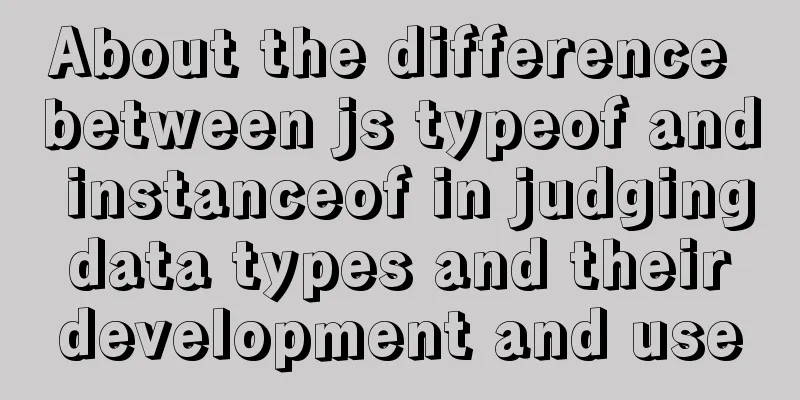About the difference between js typeof and instanceof in judging data types and their development and use

|
Preface: In daily development, we often encounter situations where we need to determine the data type of a variable or whether the variable is null. How do you choose the operator to determine the type? This article summarizes and records the knowledge points about 1. typeof operator (1) The return value is a string type, where:
(2) Common usage methods
console.log(typeof undefined); //'undefined'
console.log(typeof true);//'bpplean'
console.log(typeof ("number")); //'string'
console.log(typeof "number"); //'string'
console.log(typeof 1);//'number'
console.log(typeof Symbol());//'symbol'
//For special objects such as Array and Null, typeof will always return object, which is the limitation of typeof console.log(typeof null); //'object'
console.log(typeof [1, 2, 3]);//'object'
console.log(typeof undefined); //'undefined'
//Use the typeof operator to distinguish functions from other objects function f1() { console.log(111); }
console.log(typeof f1); //'function'
console.log(typeof f1()); // 111 'undefined'
(3) You cannot use typeof to determine whether a variable exists
var a;
if (a === undefined) {
console.log("variable does not exist")
} else {
console.log("variable exists")
}
// The variable does not exist2. instanceof operator While
function f1() { console.log(111);
console.log(f1 instanceof Object);//true
console.log(f1 instanceof Function);//true
console.log(f1 instanceof RegExp); //false
All reference values are instances of
function myInstanceof(left, right) {
let proto = Object.getPrototypeOf(left), // Get the prototype of the object prototype = right.prototype; // Get the prototype object of the constructor function // Determine whether the prototype object of the constructor function is on the prototype chain of the object while (true) {
if (!proto) return false;
if (proto === prototype) return true;
proto = Object.getPrototypeOf(proto);
}
}
3. The difference between typeof and instanceof and suggestions for use in development Both
It can be seen that the above two methods have disadvantages and cannot meet the needs of all scenarios. If you need to detect data types in general, it is recommended to use
console.log(Object.prototype.toString.call(undefined)) //"[object Undefined]"
console.log(Object.prototype.toString.call(true)) // "[object Boolean]"
console.log(Object.prototype.toString.call('1')) // "[object String]"
console.log(Object.prototype.toString.call(1)) // "[object Number]"
console.log(Object.prototype.toString.call(Symbol())) // "[object Symbol]"
console.log(Object.prototype.toString.call({})) // "[object Object]"
console.log(Object.prototype.toString.call(function () { })) // "[object Function]"
console.log(Object.prototype.toString.call([])) //"[object Array]"
console.log(Object.prototype.toString.call(null)) //"[object Null]"
console.log(Object.prototype.toString.call(/123/g)) //"[object RegExp]"
console.log(Object.prototype.toString.call(new Date())) //"[object Date]"
Summarize: This is the end of this article about the difference between You may also be interested in:
|
<<: Solution to navicat automatically disconnecting from the database after a period of time
>>: HTML tutorial, HTML default style
Recommend
Detailed tutorial on installing phpMyAdmin on Ubuntu 18.04
We will install phpMyAdmin to work with Apache on...
Install CentOS system based on WindowsX Hyper-V
At present, most people who use Linux either use ...
Detailed explanation of common commands in Docker repository
Log in docker login Complete the registration and...
How to build a DHCP server in Linux
Table of contents 1. Basic knowledge: 2. DHCP ser...
A brief discussion on MySQL index design principles and the differences between common indexes
Index definition: It is a separate database struc...
Use CSS to draw a file upload pattern
As shown below, if it were you, how would you ach...
Introduction to new features of MySQL 8.0.11
MySQL 8.0 for Windows v8.0.11 official free versi...
Summary of the style modification of the input box of type="file"
What is the input type="file"? I don'...
JavaScript data structure bidirectional linked list
A singly linked list can only be traversed from t...
Box-shadow and drop-shadow to achieve irregular projection example code
When we want to add a shadow to a rectangle or ot...
The implementation principle of Vue router-view and router-link
use <div id="app"> <router-lin...
Vue echarts realizes dynamic display of bar chart
This article shares the specific code of vue echa...
Detailed explanation of Kubernetes pod orchestration and lifecycle
Table of contents K8S Master Basic Architecture P...
Summary of methods to check whether the port is open in Linux
Method 1: Use lsof command We can use the lsof co...
How to implement a single file component in JS
Table of contents Overview Single file components...









